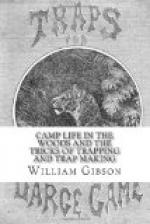[Illustration]
The board stretchers are used only for those skins which are taken off whole, that is, as described in the chapter on the otter. The skin should be drawn tightly over the blunt end of the board, and its edges either caught in notches cut in the edges of the square end or secured by a few tacks. This stretcher is particularly [Page 274] adapted to the skins of muskrats, minks and animals of a like size. They are known in New England as “shingle stretchers,” and are much to be recommended on account of their lightness and the ease with which they can be made and carried.
The wedge stretcher is rather more elaborate than the foregoing, and is said to be an improvement.
[Illustration]
The first requisite is a board of about three-eighths of an inch in thickness, two feet or more in length, and three and a half inches at one end tapering to the width of two inches at the other. This end should now be rounded, and the edges of the board whittled off to a blunt edge, as already described in the foregoing, commencing near the centre of the board, and thinning to the edge, and finishing with the notches at the square end. Now, by the aid of a rip-saw, sever the board through the middle lengthwise.
The wedge is the next thing to be constructed, and should consist of a piece of wood the thickness of the centre of the board and of the same length, tapering from an inch in width at one end to half an inch at the other.
To use the stretcher the two boards are inserted into the skin, (the latter with the fur side inward). The wedge is then inserted between the large ends of the boards and driven in sufficiently to stretch the pelt to its full capacity, securing it in the notches by slight cuts in the hide, or by a tack or two at the edge. It should then he hung in a cool, airy place, and the pelt left to “season.”
The bow stretcher is another contrivance very commonly used for small skins like the foregoing. When this is used the pelt should be skinned as described on page 185, the initial cut commencing at the lower jaw and extending down between the fore legs, all the feet being previously cut off. The bow may consist of a switch of any elastic wood such as hickory iron wood, elm or birch. It should be about three or more feet in length, and as large as a man’s thumb at the butt end. By bending it in the shape of the letter U it may easily be inserted in the skin, the latter being [Page 275] fastened by catching the lip on each side into a sliver notch cut on each end of the bow, as our illustration indicates.
[Illustration]
For large animals, such as the deer, bear, beaver, the hoop stretcher is generally employed.




